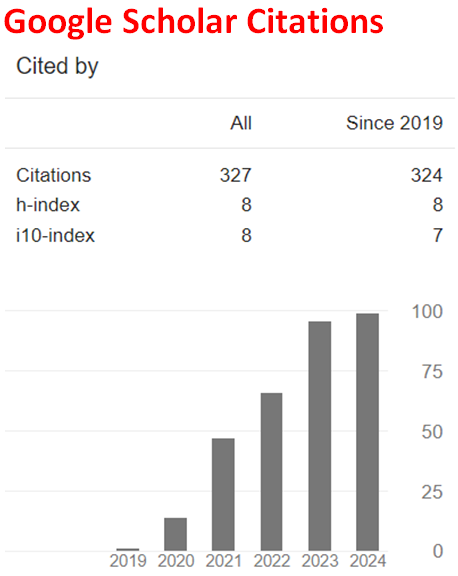Interaction of DMAZ and TEMED - A DFT Treatise
Abstract
In the present study, interaction of DMAZ and TEMED has been investigated within the limitations of density functional theory at the level of B3LYP/6-31++G(d,p). DMAZ is an explosive material but it is also oxidant constituent of some hypergolic systems. TEMED or TEMEDA acts as the partner of DMAZ. The interaction has been investigated and the findings reveal that in the absence of any hypergolic reaction, the interaction is of mainly electrostatic in nature, no bond cleavages or new bond formations happen. The variations are only of conformational in character. The composite is electronically stable in the static conditions and thermally favorable. Some quantum chemical, electronic and spectral data have been collected and discussed.
Downloads
References
Jyoti, B.V.S., Naseem, M.S., & Baek, S.W. (2017). Hypergolicity and ignition delay study of pure and energized ethanol gel fuel with hydrogen peroxide. Combustion and Flame, 176, 318-325. https://doi.org/10.1016/j.combustflame.2016.11.018
da Silva, G., & Iha, K. (2012). Hypergolic systems: A review in patents. J. Aerosp. Technol. Manag., São José dos Campos, 4(4), 407-412. https://doi.org/10.5028/jatm.2012.04043812
U.S. Patent Number: 7,954,754 (2011). Hypergolic liquid or gel fuel mixtures, Application number: 12,131,248, Date of Patent: 7 Jun (2011). U.S. Army combat capabilities development command aviation & missile center.
Di Salvo, R. (2012). High energy, low temperature gelled bi-propellant formulation preparation method. U.S. Patents 2012/0073713 A1.
Hawkins, T.W., Schneider, S., Drake, G.W., Vaghjiani, G., & Chambreau, S. (2011). Hypergolic fuels. U.S. Patents 8,034,202 B1.
Koppes, W.M., Rosenberg, D.M., Clark, K.A., Schlegel, E.S., Vos, B.W., Lang, J.W., & Warren, A.D. (2010). Reagents for hypergolic ignition of nitroarenes. U.S. Patents 7,648,602 B1.
Natan, B., Valeriano, P., & Yair, S. (2011). Hypergolic ignition system for gelled rocket propellant. World Intellectual Property Organization, WO2011/001435 A1.
Sengupta, D. (2008). High performance, low toxicity hypergolic fuel. U.S. Patents 2008/0202655 A1.
Smith, J.R., Ogden, G.E., Brown, C.J., Frisby, P.M., & Torabzadeh, S.A. (2010). Hydroxyethylhydrazinium nitrate-acetone formulations and methods of making hydroxyethylhydrazinium nitrate-acetone formulations. U.S. Patents 2010/0287824 A1.
Watkins, W.B., (2004). Hypergolic fuel system. U.S. Patents US2004/0177604 A1.
Lauck, F., Negri, M., Freudenmann, D., & Schlechtriem, S. (2019). Study on hypergolic ignition of ionic liquid solutions. 8th European Conference for Aeronautics and Space Sciences (EUCASS), 1-10. https://doi.org/10.13009/EUCASS2019-653
Melof, B., Grube, M., Sun, C., Tang, S., & Zhang, X. (2017). Role of cation structures for energetic performance of hypergolic ionic liquids. Energy & Fuels, 31, 10055-10059. https://doi.org/10.1021/acs.energyfuels.7b01259
Kang, H., & Kwon, S. (2017). Green hypergolic combination: Diethylenetriamine-based fuel and hydrogen peroxide. Acta Astronautica, 137, 25-30. https://doi.org/10.1016/j.actaastro.2017.04.009
Schneider, S., Hawkins, T., Ahmed, Y., Rosander, M., Mills, J., & Hudgens, L. (2011). Green hypergolic bipropellants: H2O2 / hydrogen-rich ionic liquids. Agnewande Chemie International Edition, 50, 5886-5888. https://doi.org/10.1002/ange.201101752
Kan, B. , Heister, S., & Paxson, D. (2017). Experimental study of pressure gain combustion with hypergolic rocket propellants. Journal of Propulsion and Power, 33, 112-120. https://doi.org/10.2514/1.B36195
Kurilov, M., Kirchberger, C., Freudenmann, D., Siefel, A., & Ciezki, H. (2018). A method for screening and identification of green hypergolic bipropellants. International Journal of Energetic Materials and Chemical Propulsion, 17(3), 183-203. https://doi.org/10.1615/intjenergeticmaterialschemprop.2018028057
Kim, Y.-S., Son, G.-H., Na, T.-K., & Choi, S.-H. (2015). Synthesis and physical and chemical properties of hypergolic chemicals such as N,N,N-trimethylhydrazinium and 1-ethyl-4-methyl-1,2,4-triazolium salts. Applied Sciences, 5(4), 1547-1559. https://doi.org/10.3390/app5041547
Chinnam, A., Petrutik, N., Wang, K., Shlomovich, A., Shamis, O., Toy, D., Suceska, M., Yan, Q.-L., Dobrovetsky, R., & Gozin, M. (2018). Effects of closo-icosahedral periodoborane salts on hypergolic reactions of 70% H2O2 with energetic ionic liquids. Journal of Materials Chemistry A, 6, 19989-19997. https://doi.org/10.1039/C8TA03780A
Daimon, W., Gotoh, Y., & Kimura, I. (2012). Mechanism of explosion induced by contact of hypergolic liquids, J. Propulsion, 7(6), 946-952. https://doi.org/10.2514/3.51323
Pourpoint, T.L., & Anderson, W.E. (2007). Hypergolic reaction mechanisms of catalytically promoted fuels with rocket grade hydrogen peroxide, Combustion Science and Technology, 10, 2107-2133. https://doi.org/10.1080/00102200701386149
Stewart, J.J.P. (1989). Optimization of parameters for semi empirical methods I. J. Comput. Chem., 10, 209-220. https://doi.org/10.1002/jcc.540100208
Stewart, J.J.P. (1989). Optimization of parameters for semi empirical methods II. J. Comput. Chem., 10, 221-264. https://doi.org/10.1002/jcc.540100209
Leach, A.R. (1997). Molecular modeling. Essex: Longman.
Kohn, W., & Sham, L.J. (1965). Self-consistent equations including exchange and correlation effects. Phys. Rev., 140, 1133-1138. https://doi.org/10.1103/PhysRev.140.A1133
Parr, R.G., & Yang, W. (1989). Density functional theory of atoms and molecules. London: Oxford University Press.
Becke, A.D. (1988). Density-functional exchange-energy approximation with correct asymptotic behavior. Phys. Rev. A, 38, 3098-3100. https://doi.org/10.1103/PhysRevA.38.3098
Vosko, S.H., Wilk, L., & Nusair, M. (1980). Accurate spin-dependent electron liquid correlation energies for local spin density calculations: a critical analysis. Can. J. Phys., 58, 1200-1211. https://doi.org/10.1139/p80-159
Lee, C., Yang, W., & Parr, R.G. (1988). Development of the Colle-Salvetti correlation energy formula into a functional of the electron density. Phys. Rev. B, 37, 785-789. https://doi.org/10.1103/PhysRevB. 37.785
Cramer, C.J. (2004). Essentials of computational chemistry. Chichester, West Sussex: Wiley.
SPARTAN 06 (2006). Wavefunction Inc. Irvine CA, USA.
Pakdehi, S.G., Rezaei, S., Motamedoshariati, H., & Keshavarz, M.H. (2014). Sensitivity of dimethyl amino ethyl azide (DMAZ) as a non-carcinogenic and high performance fuel to some external stimuli. Journal of Loss Prevention in the Process Industries, 29, 277- 282. https://doi.org/10.1016/j.jlp.2014.03.006
Türker, L. (2011). Recent developments in the theory of explosive materials. In J. Thomas (Ed.). Explosive materials (pp. 1-52). New York: NOVA Pub.
Barrow, G.M. (1962). Introduction to molecular spectroscopy. Tokyo: McGraw-Hill (Int. Student Ed.).
Harris, D.C., & Bertolucci, M.D. (1978). Symmetry and spectroscopy: an introduction to vibrational and electronic spectroscopy. New York: Oxford University Press.
Ayers, P.W., & Parr, R.G. (2000). Variational principles for describing chemical reactions: The Fukui function and chemical hardness revisited, J. Am. Chem. Soc., 122, 2010-2018. https://doi.org/10.1021/ja9924039
Hampton, C.S., Ramesh, K.K., & Smith, J.E. (2003). Importance of chemical delay time in understanding hypergolic ignition behaviors. AIAA-2003-1359. 41st Aerospace Sciences Meeting and Exhibit. https://doi.org/10.2514/6.2003-1359

This work is licensed under a Creative Commons Attribution 4.0 International License.


